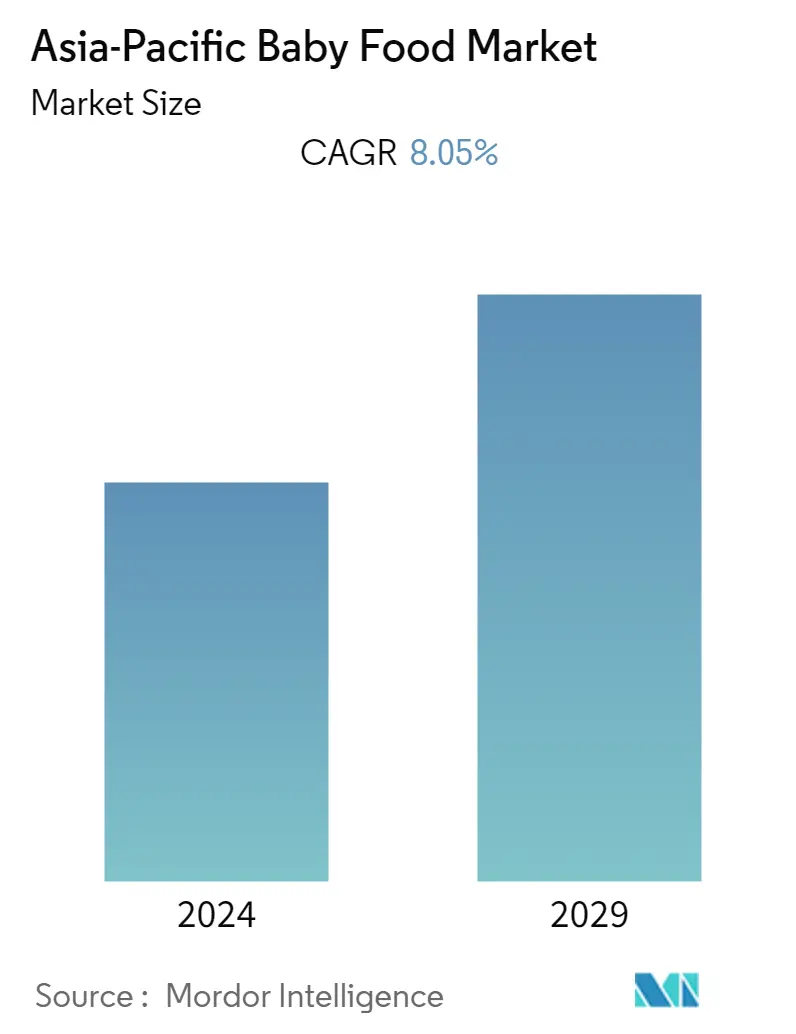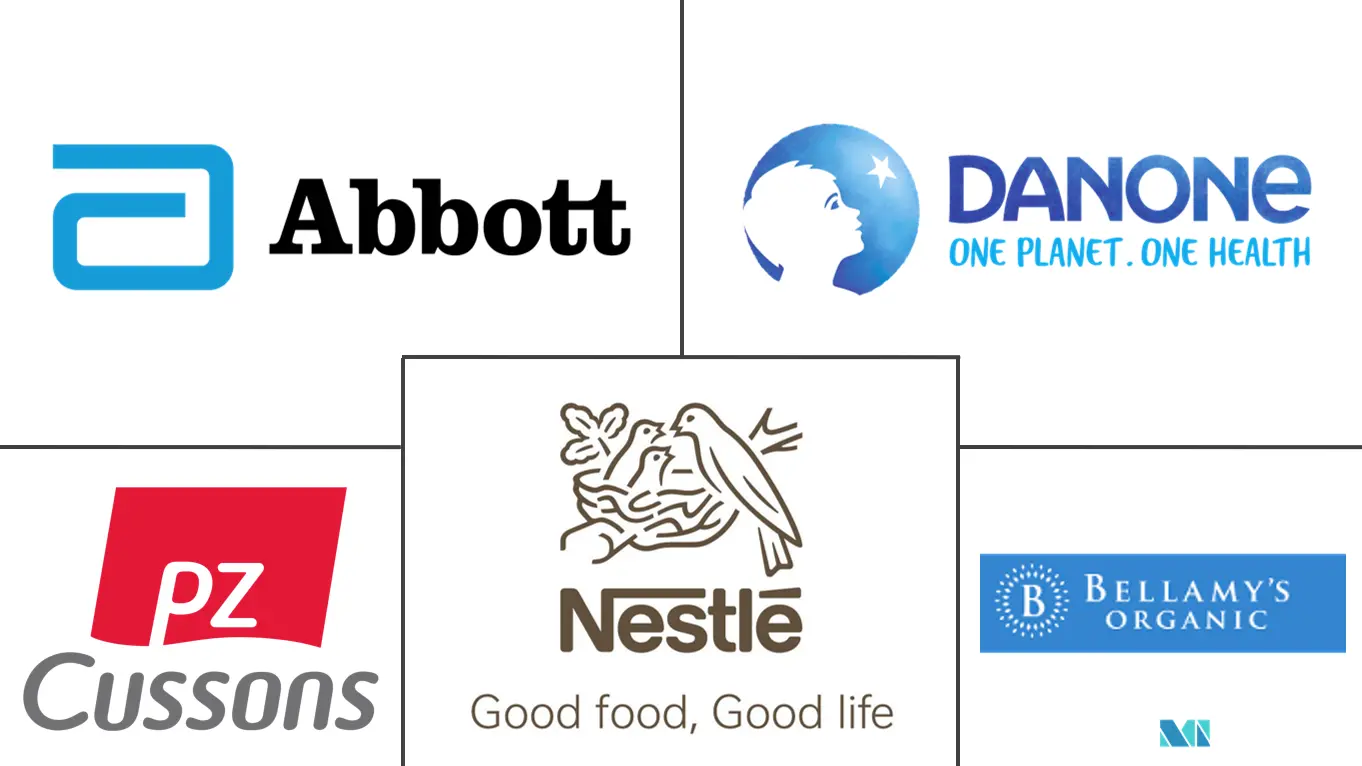Market Size of Asia-Pacific Baby Food Industry

| Study Period | 2019 - 2029 |
| Base Year For Estimation | 2023 |
| Forecast Data Period | 2024 - 2029 |
| Historical Data Period | 2019 - 2022 |
| CAGR | 8.05 % |
| Market Concentration | Low |
Major Players
*Disclaimer: Major Players sorted in no particular order |
APAC Baby Food Market Analysis
The Asia-Pacific baby food market is projected to register a CAGR of 8.05% in the forecast period.
The Asia-Pacific baby food industry is driven by the rising number of malnutrition instances, the increasing number of working women, and concerns for the overall growth of babies. Parents have boosted their spending due to rising disposable income. The rising working population, particularly among women, and urbanization have fostered convenience-oriented lifestyles, boosting the demand for organic baby food and, consequently, baby food sales. The Asia-Pacific baby food market witnessed a shift from conventional to organic products, owing to factors such as a rise in parental concerns over baby nutrition, increased awareness concerning the benefits associated with organic products, and eco-friendly farming techniques. These factors are expected to boost the demand for organic baby food products. Hence, the demand for baby food with no added preservatives is surging at a robust pace globally. To capitalize on the growing demand, key players in the market are focusing on introducing lactose-free, gluten-free products with zero added preservatives.
Government initiatives may further drive the growth of the region's baby food market. For instance, from 2021 through 2025, the National Health Commission of China (NHC) released a new action plan for improving child health. By 2025, the death rates of newborn babies, infants, and children under the age of five will be maintained below 3.1, 5.2, and 6.6 per thousand, respectively, according to the action plan. In addition, the rate of growth retardation among children under the age of five will be kept to less than 5%. The strategy focuses on seven major areas, including newborn protection, congenital disability prevention, healthcare, and early childhood development services.
APAC Baby Food Industry Segmentation
Baby food is any soft, easily digestible meal created particularly for human babies aged 4-6 to two years old.
The Asia-Pacific baby food market is segmented by type (milk formula, dried baby food, prepared baby food, and other types), distribution channel (hypermarket/supermarket, drugstores/pharmacies stores, convenience stores, online retail stores, and other distribution channels), and geography (India, China, Japan, Australia, and Rest of Asia-Pacific). The report offers market size and values in (USD million) during the forecast period for the above segments.
| Type | |
| Milk Formula | |
| Dried Baby Food | |
| Prepared Baby Food | |
| Other Types |
| Distribution Channel | |
| Hypermarkets/Supermarkets | |
| Drugstores/Pharmacies Stores | |
| Convenience Stores | |
| Online Retail Stores | |
| Other Distribution Channels |
| Geography | |
| India | |
| China | |
| Japan | |
| Australia | |
| Rest of Asia-Pacific |
Asia-Pacific Baby Food Market Size Summary
The Asia-Pacific baby food market is experiencing significant growth, driven by factors such as increasing malnutrition instances, a rising number of working women, and heightened concerns about infant nutrition. The market is witnessing a shift from conventional to organic baby food products, fueled by parental awareness of the benefits of organic and eco-friendly farming techniques. This shift is further supported by the growing demand for baby food without added preservatives, as parents prioritize the health and well-being of their children. The trend towards convenience-oriented lifestyles, particularly in urban areas, is also contributing to the rising popularity of ready-to-eat and packaged baby foods. Government initiatives, such as China's National Health Commission's action plan, are expected to further bolster the market by focusing on child health and development.
The Asia-Pacific baby food market is characterized by intense competition, with major players like Nestle SA, Abbott Laboratories, and Danone SA actively expanding their product offerings and investing in research and development. The market is also seeing a rise in vegan-based baby foods, catering to the growing demand for plant-based nutrition. China, as a dominant player in the region, is witnessing increased demand due to its large population and urbanization trends. Parents are willing to invest in high-quality, organic baby food products, driving the market's expansion. The introduction of innovative products, such as Nestle's carbon-neutral formula and PZ Cussons' Vegemite Cheesy Bread Sticks, highlights the industry's focus on meeting diverse consumer preferences and enhancing baby nutrition.
Asia-Pacific Baby Food Market Size - Table of Contents
-
1. MARKET DYNAMICS
-
1.1 Market Drivers
-
1.2 Market Restraints
-
1.3 Porter's Five Forces Analysis
-
1.3.1 Threat of New Entrants
-
1.3.2 Bargaining Power of Buyers/Consumers
-
1.3.3 Bargaining Power of Suppliers
-
1.3.4 Threat of Substitute Products
-
1.3.5 Intensity of Competitive Rivalry
-
-
-
2. MARKET SEGMENTATION
-
2.1 Type
-
2.1.1 Milk Formula
-
2.1.2 Dried Baby Food
-
2.1.3 Prepared Baby Food
-
2.1.4 Other Types
-
-
2.2 Distribution Channel
-
2.2.1 Hypermarkets/Supermarkets
-
2.2.2 Drugstores/Pharmacies Stores
-
2.2.3 Convenience Stores
-
2.2.4 Online Retail Stores
-
2.2.5 Other Distribution Channels
-
-
2.3 Geography
-
2.3.1 India
-
2.3.2 China
-
2.3.3 Japan
-
2.3.4 Australia
-
2.3.5 Rest of Asia-Pacific
-
-
Asia-Pacific Baby Food Market Size FAQs
What is the current Asia-Pacific Baby Food Market size?
The Asia-Pacific Baby Food Market is projected to register a CAGR of 8.05% during the forecast period (2024-2029)
Who are the key players in Asia-Pacific Baby Food Market?
Nestle S.A, Abbott Laboratories, Danone S.A., PZ Cussons plc and Bellamy's Organic are the major companies operating in the Asia-Pacific Baby Food Market.

